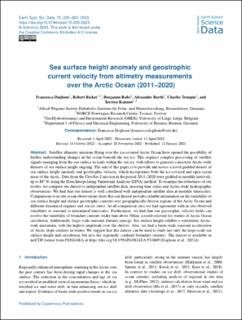| dc.contributor.author | Doglioni, Francesca | |
| dc.contributor.author | Ricker, Robert | |
| dc.contributor.author | Rabe, Benjamin | |
| dc.contributor.author | Barth, Alexander | |
| dc.contributor.author | Troupin, Charles | |
| dc.contributor.author | Kanzow, Torsten | |
| dc.date.accessioned | 2023-08-17T10:41:01Z | |
| dc.date.available | 2023-08-17T10:41:01Z | |
| dc.date.created | 2023-02-13T14:58:49Z | |
| dc.date.issued | 2023 | |
| dc.identifier.citation | Earth System Science Data. 2023, . | en_US |
| dc.identifier.issn | 1866-3508 | |
| dc.identifier.uri | https://hdl.handle.net/11250/3084555 | |
| dc.description.abstract | Satellite altimetry missions flying over the ice-covered Arctic Ocean have opened the possibility of further understanding changes in the ocean beneath the sea ice. This requires complex processing of satellite signals emerging from the sea surface in leads within the sea ice, with efforts to generate consistent Arctic-wide datasets of sea surface height ongoing. The aim of this paper is to provide and assess a novel gridded dataset of sea surface height anomaly and geostrophic velocity, which incorporates both the ice-covered and open ocean areas of the Arctic. Data from the CryoSat-2 mission in the period 2011–2020 were gridded at monthly intervals, up to 88∘ N, using the Data-Interpolating Variational Analysis (DIVA) method. To examine the robustness of our results, we compare our dataset to independent satellite data, mooring time series and Arctic-wide hydrographic observations. We find that our dataset is well correlated with independent satellite data at monthly timescales. Comparisons to in situ ocean observations show that our dataset provides reliable information on the variability of sea surface height and surface geostrophic currents over geographically diverse regions of the Arctic Ocean and different dynamical regimes and sea ice states. At all comparison sites we find agreement with in situ observed variability at seasonal to interannual timescales. Furthermore, we find that our geostrophic velocity fields can resolve the variability of boundary currents wider than about 50 km, a result relevant for studies of Arctic Ocean circulation. Additionally, large-scale seasonal features emerge. Sea surface height exhibits a wintertime Arctic-wide maximum, with the highest amplitude over the shelves. Also, we find a basin-wide seasonal acceleration of Arctic slope currents in winter. We suggest that this dataset can be used to study not only the large-scale sea surface height and circulation, but also the regionally confined boundary currents. The dataset is available in netCDF format from PANGAEA at https://doi.org/10.1594/PANGAEA.931869 (Doglioni et al., 2021d). | en_US |
| dc.language.iso | eng | en_US |
| dc.rights | Navngivelse 4.0 Internasjonal | * |
| dc.rights.uri | http://creativecommons.org/licenses/by/4.0/deed.no | * |
| dc.title | Sea surface height anomaly and geostrophic current velocity from altimetry measurements over the Arctic Ocean (2011–2020) | en_US |
| dc.title.alternative | Sea surface height anomaly and geostrophic current velocity from altimetry measurements over the Arctic Ocean (2011–2020) | en_US |
| dc.type | Peer reviewed | en_US |
| dc.type | Journal article | en_US |
| dc.rights.holder | © Author(s) 2023 | en_US |
| dc.description.version | publishedVersion | en_US |
| cristin.ispublished | true | |
| cristin.fulltext | original | |
| cristin.qualitycode | 1 | |
| dc.identifier.doi | 10.5194/essd-15-225-2023 | |
| dc.identifier.cristin | 2125705 | |
| dc.source.journal | Earth System Science Data | en_US |
| dc.source.pagenumber | 39 | en_US |

